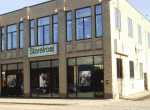
For small business retailers, competition can be very stiff indeed. Big retailers with huge marketing budgets, good locations and large human resources can make the constant struggle for customers very tough. Then there is the internet. Customers have started to desert the traditional high street in favour of the convenience and prices offered by online retailers. So, with all this competition eating away at your potential customer base, it is vitally important that you make the most of every single customer that crosses your threshold.
First Impressions Count
Visual merchandising can play a crucial role in converting your customer visits into sales and importantly, encouraging repeat visits to your shop. It does this in a variety of different ways.
Good presentation makes your store look neat, tidy and appealing and nobody likes to shop in an untidy, cluttered and disorganised shop. It makes browsing difficult and looks amateur.
A clean, well ordered store lets a customer know you are a professional setup and that they can spend their money with you, with confidence.
Visual merchandising can also play an important part in conveying your company's branding and identity, using your company colour scheme along with consistent pieces of retail equipment, to communicate your identity through displays and shop fittings.
But perhaps the most important function of attractive, functional displays, certainly from a revenue generation perspective, is to present your products to best advantage, putting them in front of your customers and giving them context, increasing the chance of purchase.
Picture This...
This contextualization varies from one product category to the next. With fashion garments it is about creating evocative displays, with the right fashion mannequins and props to enhance the quality of the clothes.
Creating a specific scene and setting for the garments with a display, giving them an extra layer of context, will make it easier for the customer to picture themselves wearing them and is much more effective sales tool than neatly folded clothes on a shelf.
For other products, the best way to make your visual merchandising 'sell' for you, will obviously differ. For technology based products for example, the displays must allow for customer interaction and experimentation with the items, along with information on all the technical specifications, to encourage purchase.
Experiment
At its most basic, immediate level, time and effort spent on visual merchandising will give you a better understanding of your products and how best to present them to generate the most sales.
This is a process that will take time, as you refine your displays to achieve a formula that works best for your shop, merchandise and the customers who visit you.
Experiment and don't be afraid to try something new. Switch things around, try different pieces of retail furniture if you have them and move products to different areas of the shop, tweaking the flow and layout.
If something helps, them keep it. If it doesn't, don't worry. Do something else and move on.
Customer Feedback
Running a small business brings you into closer contact with the customers you serve and this more intimate relationship can help you refine your approach to visual merchandising.
Talk to your customers if you can and find out what they think of your layout and displays. Did they find it easy to find everything they wanted? Do they think the displays you put together are attractive and a credit to your shop?
At the end of the day, it is your business and you have the ultimate say, but customer feedback can be invaluable in discerning what is effective and what can be discarded in your approach.
Don't Be Afraid: Have A Go
It is important not to feel overwhelmed by visual merchandising, worrying that your displays are not stylish enough or not appealing to some deep psychological need in your clientele.
Setup some displays and get the products where your customers can see them, listen to feedback from visitors to your store and importantly, the cash register, and refine as you go along.
You will add your own style and personality to the way you arrange your products and that distinctive nature in many ways plays to the unique selling point of small business.
Shoppers don't visit smaller shops and stores for a uniform, multiple retail environment. Individuality and a unique look is a strength of small business and you should not be afraid to express yourself!
William Shane works for the mannequin supplier, Mannequin Bazaar. They sell a wide variety of different mannequins and other retail equipment, to help visual merchandiser create really useful, dramatic and powerful displays.
